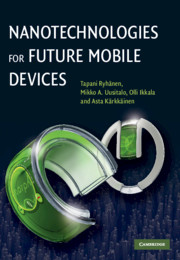Book contents
- Frontmatter
- Contents
- List of contributors
- Preface
- 1 When everything is connected
- 2 On the possible developments for the structural materials relevant for future mobile devices
- 3 Energy and power
- 4 Computing and information storage solutions
- 5 Sensing, actuation, and interaction
- 6 Future of Radio and Communication
- 7 Flat panel displays
- 8 Manufacturing and open innovation
- 9 Seeing beyond the hype: what the Internet teaches us about the development of nanotechnology
- 10 Conclusions
- Index
- References
6 - Future of Radio and Communication
Published online by Cambridge University Press: 05 July 2014
- Frontmatter
- Contents
- List of contributors
- Preface
- 1 When everything is connected
- 2 On the possible developments for the structural materials relevant for future mobile devices
- 3 Energy and power
- 4 Computing and information storage solutions
- 5 Sensing, actuation, and interaction
- 6 Future of Radio and Communication
- 7 Flat panel displays
- 8 Manufacturing and open innovation
- 9 Seeing beyond the hype: what the Internet teaches us about the development of nanotechnology
- 10 Conclusions
- Index
- References
Summary
Introduction
Rapid progress in radio systems since the early 1990s has fundamentally changed all human communication. Mobile phones and the Internet have enabled globalization of both private and business communication and access to information. This has required increased data rates and capacity as well as the means to achieve a reliability similar to that of wireline systems. On the other hand, the importance of local information whether it is the opening hours of a local shop or finding friends in the vicinity will increase the role of short-range radios.
New forms of mobile communication, e.g. location-based services, will increase the need for enhanced performance of connectivity. In the future everything will be connected through embedded intelligence. Not only will people be communicating but things will also be connected. The first step toward the Internet of Things is to enhance the usability of the current devices by better connection to the services. All the capacity that can be provided is likely to be used. The hype about ubiquitous communication will not be realized unless extremely cheap, small, low-power wireless connection devices can be created for personal area and sensor networks. The goal is to have data rates which are comparable to wireline connections today. This will require very wide bandwidths with radio frequency (RF) operation frequencies in the gigahertz range.
However, a wider bandwidth is not the only way to obtain more capacity. As discussed later in this chapter, cognitive radio will provide a new paradigm to embed intelligence not only at the application level but also in the radio connectivity. In brief, it promises to share radio spectrum autonomously and more dynamically than previously, thus allowing better spatial spectrum efficiency, i.e., more capacity using the same bandwidth.
- Type
- Chapter
- Information
- Nanotechnologies for Future Mobile Devices , pp. 174 - 212Publisher: Cambridge University PressPrint publication year: 2010
References
- 1
- Cited by



